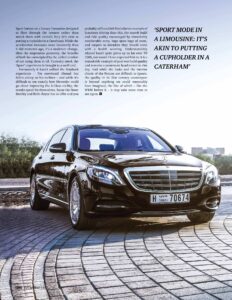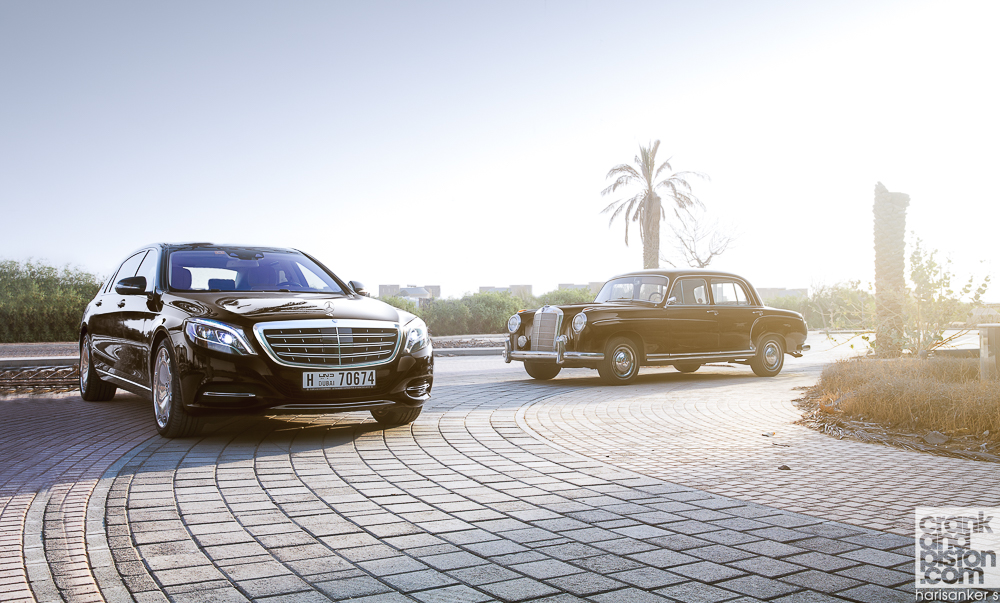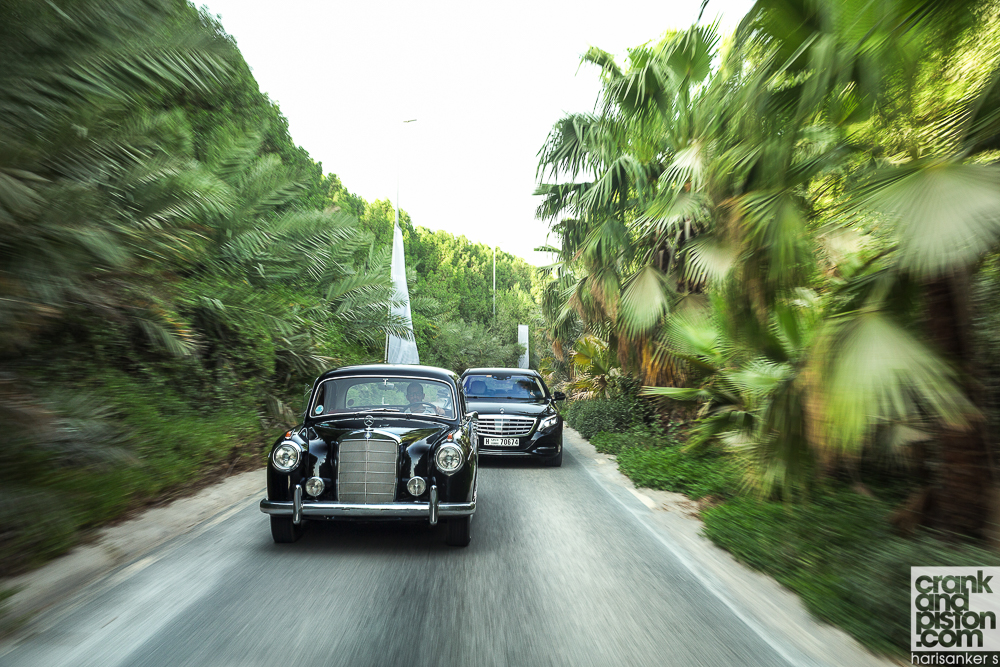Mercedes-Maybach meets ’59 Mercedes W180 220S
Features | crankandpiston | EVO Middle East
The Mercedes-Maybach division takes the superlative S-Class and makes it more luxurious. It’s a pattern Mercedes has developed over the years…
Originally posted – 3 November, 2015
crankandpiston.com | EVO Middle East magazine (PDF)
“…holy crap, these seats are comfortable!”
Ahmad sitting next to me can’t help but stifle a small laugh. This pristine 1959 W180 220S after all has been with his family for three generations, and though he regularly enjoys sharing the experience with friends, family and the occasional automotive journalist, it’s rare he actually lets someone but himself behind the wheel. My mini-outburst aside, I can already tell this is not going to be your standard test drive. The heritage alone backs that up.
In 1954, five years before Ahmad’s 220S rolled off the hand built production line, Daimler introduced its first brand new series since World War II, the W180. A more up-scale alternative to the W120 that hitherto had been the company’s mainstay model. The newboy though – the 220a – featured a longer wheelbase, assigned to support the six-cylinder engine that would power the W180 series until production ended. By 1956, power from said straight-six had been upped from ‘more than you need’ to 105bhp – and later 120bhp when twin carburettors were installed – when the updated 220S was introduced in Frankfurt. As you can imagine, it’s not a significant amount of power I’m being ‘forced’ to deal with, but the operation involved is slightly more Germanic than I had expected.
The manual gearbox for instance is not mounted by my right hip. The 220S instead utilises a column-shift four-speed (plus reverse), a familiar layout for large SUVs and pick-up trucks but slightly random for a luxury limousine, particularly since the manual layout remains intact: pull the thin – and, to my mind, very fragile – gear ‘lever’ back and down, and click into place to select first; move up and click again to select second.
As a process, it’s very straightforward, since the clutch has been abandoned altogether in favour of a torque converter. And yet in operation, I worry not only that the lever may pry loose in my hands – this is delicate 1950s craftsmanship we’re dealing with here – but that a fudged gear change could spell big trouble for the six-cylinder under the bonnet. Trouble that my bank balance won’t be able to cover without a sizable loan.
Fortunately fate plays ball today, and we start to pick up speed. Not unduly, obviously – even in its day, top speed for the 220S was just over 160kph – but enough to get a sense of the refinery involved, and it’s difficult not to see that in the design of the 220S alone.
Compared with the Mercedes-Maybach S600 I’ve turned up in for today’s test (I’ll come back to that in a minute), the only leather we find in the cabin is on the seats – have I mentioned how comfortable they are? – while the dashboard is trimmed elegantly with wood. The steering wheel is enormous, and suitably ornate. The horn is activated by pushing the inner chrome circle mounted to the wheel itself, which I find both charming and hilarious. There are more buttons on the dash than I know what to do with alongside the customary ‘up-scale’ Mercedes clock. The only modern embellishments are an aftermarket stereo and a revolting-looking air conditioning system by the passenger footwell, although given the ungodly humidity we’re dealing with today, I can understand why that’s here.
Undoubtedly the cabin is a piece of antiquated beauty, my personal favourite touch being the small winglet windows. They’re fully open to let some of the oppressive heat out, even though they can’t quite measure up to the task. One slight drawback though is the seat itself, adjustment options for which are limited: when cornering I have to shuffle the almost impossibly delicate wheel between my hands since the wheel is balancing on my legs.
Surprisingly, even with only limited power-assisted steering options, there is plenty of give in the wheel. The connection with the front wheels is questionable –this is a luxury saloon we’re talking about – but the manoeuvrability of the front end is really quite impressive. Not that I’m about to start discussing ‘balance’ or ‘poise’, for although those front tyres are surprisingly grippy, there’s an enormous amount of body roll as I feed the gigantic wheel through my hands. And yes, the diminutive 13in alloys and the über soft suspension do little to counter this.
My shocked expression as we totter around each corner once again has clearly amused Ahmad: I don’t immediately notice, but for the first few turns, I’m muttering to myself in concentration, trying to remember where third gear is on the column mount.
My drive in the 220S might be short, but it leaves a lasting impression, primarily due to the comfort. Even though the S-Class measures nearly a metre shorter than the Maybach, the headroom is simply staggering. As for that matter is the ride comfort, the softened suspension floating gracefully over even the most rutted of surfaces, not that I make a point of testing that theory too far. The six-cylinder soundtrack is slightly more raucous than I’d expected but not so much to affect our conversation in the cabin: it’s a mighty sound, the surprisingly basy notes of a 2-litre six-cylinder combined with the genteel civility of a luxury limousine.
After a while though, the heat gets the better of both of us, and though Ahmad and I are keen to keep the drive going, we soon park up and make a dash for the Maybach. I take up point at the wheel as my companion slides into the reclining ottomans in the back. The S600 has been ‘specially designed to be chauffeur driven’, after all…
It’s a completely different animal, the Maybach. While the 220S boasts the chrome detailing down the doors, a one-piece front bumper and indicator bulbs on the fenders, as well as the flowing wheel arches that begat the design its famous nickname – the ‘Ponton’, German for ‘pontoon’ – the S600 is sleek and… almost aggressive the S-Class underpinnings obvious past some Maybach badges and enormous – and rather ghastly, I must say – 22in alloy wheels.
Don’t mistake this for ‘just’ an equipment line though. Not only is the Mercedes-Maybach S600 one of six variants introduced since the S-Class made its 2013 debut, it’s also Mercedes’ second sub-brand alongside AMG, one designed to produce ‘a new benchmark for exclusivity’. See if you can process that: Mercedes has taken one of the most luxurious limousines on the planet, and made it better…
Comfort and civility therefore are extraordinary. The wheelbase has been extended to offer yet more cabin space: the rear seats are now set back behind the C-pillar for ‘added privacy’. There’s a special ‘chauffeur mode’ that tilts the front passenger seat forward completely should the rear passenger wish to stretch out completely. It does rather knacker my view of the passenger-side wing mirror but does mean my passenger can use the table and ‘First Class centre console’ without fear of jamming an elbow.
Everything is either leather or high quality lacquered wood, including the steering wheel, which boasts an ornate design with only two arms. Everything is opulent and luxurious. Everything is S-Class but with, somehow, an added sense of refinery, as I find when the V12 is powered into life and we begin our test route again.
The suspension wafts so magnificently over everything that it’s easy to forget just how powerful that enormous 6-litre biturbo V12 up front really is. Even with two tonnes to shift, there’s no road noise, no wind noise, and very little engine noise to contend with in, what Mercedes calls, the world’s quietest production saloon. A point I prove my putting the hammer down a little more. The engine, though a hefty brute, accelerates so flawlessly that comfort is not affected, although given the 530bhp and 612lb ft of torque, there’s certainly plenty of potential lingering beneath the civility, as I find out when I point the Maybach’s nose at a corner.
I’m surprised. Really, genuinely surprised. I had half expected the Maybach to hit every turn like a runaway juggernaut, my impressions at the wheel one of furious arm waving and barely controlled hysteria. Turns out though that, despite the two-arm steering wheel proving a little unusual to get used to, those enormous wheels offer an astonishing amount of grip, and while the supple nature of the suspension prioritises a smooth ride quality, there’s just enough tautness to offer an impressive amount of balance through the turns. There’s still body roll to contend with and the threat of understeer is always present, but also an astonishing amount of manoeuvrability. More so than any self-respecting $170K(ish) luxury limo has any right to offer. All this with my seat massager working overtime – ‘fast and vigorously’ – on my shoulder blades.
On a straight stretch my curiosity gets the better of me, and I select Sport suspension and throttle response, give the paddle shifter a tap, and nail the right pedal. Ahmad, reclining quite happily in the back, offers no objections.
I have yet to understand why manufacturers feel the need to include a Sport button on a luxury limousine designed to flow through the corners rather than attack them with vitriolic fury: you may as well put a cupholder in a Caterham. While the acceleration increases more insistently than it did moments ago, it’s a moderate change, ditto the suspension geometry, the benefits of both far outweighed by the added comfort of not using them at all. Curiosity sated, the ‘Sport’ experiment is brought to a swift end.
Fortunately it hasn’t sullied the Maybach experience – I’m convinced Ahmad has fallen asleep on his recliner – and while it’s difficult to see exactly how Mercedes could go about improving the S-Class’ civility, the results speak for themselves. Scour the finest Bentley and Rolls-Royce alike has to offer and you probably still couldn’t find a better example of luxurious driving than this. The build quality is superb, as is the ride quality, encouraged as that is by remarkably comfortable seats, bags upon bags of room, and carpets so decadent they should come with a health warning.
Understandably Ahmad hasn’t quite given up on his own ’59 220S, nor would I have expected him too: it is a remarkable example of post war design and remains a prominent head turner to this day. And while the looks and the interior charm of the ‘Ponton’ are difficult to ignore, the quality in its 21st century counterpart is beyond anything we could reasonably have imagined. The like of which, like the W180 before it, may take some time to see again.
Images | Awesome Group and Harisanker S
Features | crankandpiston | EVO Middle East | James Gent
































